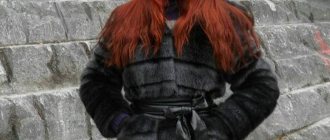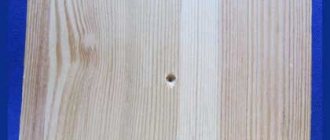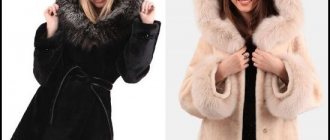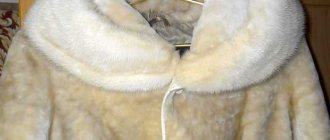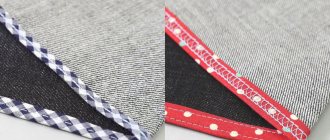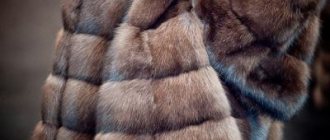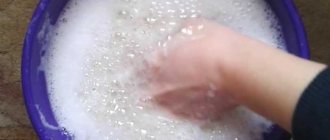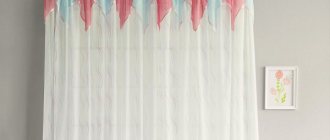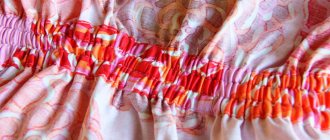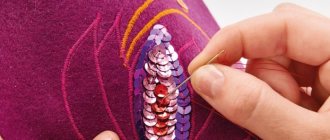Many owners of chic and elegant fur products are sure that only professionals who know their business should repair their fur coats. However, many are faced with a fairly simple problem - the hooks on their fur coat come unfastened. You can fix this at home with a little effort and a couple of simple manipulations. Which ones? Now we will tell you about this.
Preparation for repair
If the hook on a fur coat is broken, it needs to be repaired or replaced with a new one. This procedure does not require any special skills or knowledge, and the only requirement is to be able to sew so that the work is done accurately and accurately.
First of all, you need to prepare the tools that will be used:
- A piece of elastic fabric.
- Small hooks - small ones can come unfastened, but large ones look ugly.
- Needle with thread. It is best to buy a triangular needle, which is used for working with leather products.
- Stationery or furrier's knife. If you don't have them, you can use nail scissors.
General recommendations:
- The needle should be thin and long.
- You need to buy a thick thread, if you can’t find one, you can use a regular one, folding it in half or four.
- Threads and hooks must match in color so that they are practically invisible in appearance.
- If you buy new hooks, you need to check the mechanism for fastening them. It should not be tight or complicated, because in winter your fingers freeze and a heavy mechanism will not be appropriate.
- Upon completion of the repair work, take care of the pile by restoring its position with a brush.
Important! Before restoring matted fur, it must be moistened with a solution of warm water and glycerin.
Getting ready for renovation
If the hook on a fur product breaks, the part will need to be repaired or completely replaced. Replacing a hook does not require special knowledge and skills, however, you need to know at least a little sewing in order to complete the job accurately and accurately.
Tools
To work you will need the following tools:
- Furrier's or sharp stationery knife. You can also use small scissors with pointed ends (for example, manicure scissors), but working with them requires experience and dexterity.
- Needle and thread (as strong as possible). For manual work, it is best to use a special triangular needle designed for working with leather.
- Medium size hooks. A piece that is too massive will be out of place, and very small hooks can easily break or come undone.
- A piece of elastic fabric.
Adviсe:
- For sewing, choose a thin, strong and long needle to protect the flesh from damage during piercing.
- If you do not have too dense threads, then use regular thread, folding it several times.
- Choose threads and hooks that are the most suitable in color, even if they are almost invisible. The fastener should not stand out too much.
- When purchasing new hooks, pay attention to how they fasten. Please note that in frosty times your fingers sometimes do not obey, and it will be quite difficult to cope with a hook that is fastened too difficult and tight.
- Upon completion of the repair, it is necessary to restore the position of the pile. To do this, use a natural bristle brush (not very hard) or, as a last resort, a pet brush.
Important! Before restoring a matted area of fur, wet it with warm water and glycerin.
If you do not plan to replace your fur product with a new one in the near future, you need to make efforts to ensure that it remains beautiful and durable longer. And our detailed collections of tips from articles will help you with this:
- How to care for a fur coat?
- How to restore the shine of fur?
Choosing fasteners for a fur coat
The following are used as a fastener for a fur coat:
- Hooks with rings. Their system comes in three types: with a movable and a fixed or fastened element.
Important! The product can be made of plastic or metal. Naturally, metal has higher strength, so it is better to give preference to it. Plastic fittings are relevant only if the fasteners are sewn to a fur vest or short fur coat.
- Decorative fasteners in the form of hooks and clips. Decorative elements are additional decoration; most often they are used for short-pile fur products.
- Buttons.
Recommendations:
- If you use public transport to move around the city, it is better to buy fastening hooks that will not come undone under the pressure of other passengers.
- The most popular option is a metal hook with a movable tongue, as it has an attractive appearance and good reliability. They are usually used for short and long fur coats; the length of the pile can be any.
- When using a decorative hook, it is important not to overdo it, because there should only be one. It is better to place such a hook at the top and use it as a brooch or reinforcement for the hood.
On a note! You can improve the appearance of a plain fur item by using a shiny accessory with stones. The size of the decoration can be any, the main thing is to match the style of the fur coat or fur vest.
Some tips for choosing fasteners
- First of all, make sure that the style of fasteners on the fur coat matches the overall appearance of the product and is harmonious with it. If, for example, you like a fastener for a fur coat with rhinestones, and more than one, do not forget about moderation. Otherwise, you risk looking tacky.
- Pay attention to how the fasteners are fastened - this process should be effortless. But the fasteners shouldn’t unfasten on their own either.
- It is better if the base of the fastener is made of metal, since plastic breaks more easily.
- Pay attention to the fasteners, which allow you to carefully repair the product if necessary.
Remember that fur coat fasteners are the final touch that will make you look perfect and add some zest to your look.
Repairing a hook on a fur coat without replacing it
Reasons why hooks may not hold a fur item in the pile:
- Incorrect hook size. If the fittings are small, they will not hold the fur product well and need to be completely replaced.
- The threads are partially torn. In this case, it is enough to alter the hook by making additional stitches or re-sewing the hook.
- The hooks became loose over time. If the mechanism itself is broken, then you need to squeeze it with pliers. This must be done carefully, otherwise the part will break and will need to be replaced.
How to sew a hook to a fur coat?
Before you start work, you need to determine the place where the hooks will be located. After taking a series of measurements, find the optimal places for the hooks.
Important! Before sewing on the hooks, you need to remember that all fasteners are placed on the lining, without touching the main skin.
If the fastener is broken, it needs to be replaced. Before you do this, you need to do the following:
- Pull up the seam on the lining until you reach the fastener.
- Is the lining not attached? Then it is enough to turn the fur product inside out and find the desired part.
Now you can proceed to installing the hooks. In order to do this correctly, you need to strictly follow the instructions, performing all stages of the work step by step:
- If there were no fittings at the selected location, then you need to make a small cut and remove the desired part of the hook through it. If the hook is being replaced, then the place of the old fastener must be sewn up (except for the new slot), strengthening it with a piece of leather or adhesive fabric.
- Sew a hook on the inside of the lining. The base of the hook has more than one hole, so you need to sew them all, distributing the load evenly.
- Sew up the torn areas and make new seams carefully. All threads must be on the inside. The last lining is sewn to the fur board using a hidden seam.
Important! While sewing, do not pull the thread, otherwise the core will tear.
- If you need to sew on a ring, then, first of all, measurements are taken, because the hook and the ring must be located on the same level.
General recommendations:
- By strengthening the fastener with adhesive fabric or leather, you can avoid tearing or stretching of the inner membrane.
- If the fur product has a thin pile, then the ring must be secured with leather.
- A fur coat is an expensive thing, so there is no need to skimp when choosing hooks.
How to sew a button to a mink coat?
To sew an element to a fur coat of any fur yourself, you need to stock up on the materials necessary for the work:
- threads to match the fur, a long needle;
- decorative and lining (flat, small) button;
- with a match.
Process step by step:
- The place where the button will be sewn must be cleared of any remaining threads, if any.
- A thread folded in half is threaded through the needle and a knot is tied.
- The wrong side of the button is applied to the inside, through its hole a needle and thread are brought out to the front side of the fur coat.
- A decorative element is applied to the wrong side, under which a match is placed.
- The thread and needle are brought out to the wrong side, making a loop over the match. The action is repeated 10 to 15 times.
- Once again, when the thread and needle are on the front side, the match is removed and the thread is wrapped around the “leg” formed from the loop about 5 times. Thanks to this, a leg is formed that will prevent the fur from being wrinkled while using the decorative element.
- Secure the structure from the wrong side by pulling the needle through the hole and tightly tightening the loop.
While working, you need to make sure that no fur fibers get under the seam and straighten them as necessary. The direction of the pile must also be taken into account, since the fur may become wrinkled when attaching the fasteners.
Changing hooks to buttons
Owners of expensive and elegant fur products are sure that hooks are not reliable, as they break quickly, and changing them is difficult and time-consuming, so they prefer buttons. In fact, replacing hooks with buttons is extremely difficult, because you need to form the loop correctly, which means you need to have a special technique that allows you to process the edges correctly. Otherwise, the pile will simply fall off in the places where the cuts are made.
If replacing hooks with buttons is necessary and the appropriate decision has been made, we recommend that you listen to these useful tips:
- To replace hooks with buttons, you must carefully remove the old fittings, sewing up all the holes with light stitches. From the inside, you need to lay adhesive tape in the place where the hook used to be, after which you can sew on the button.
- It is better to make the loops internal, as it is much simpler. The loops should be formed from dense threads.
In general, there is nothing difficult in installing hooks and rings and you can cope with this task by listening to our advice. The main thing is to do the work extremely carefully, because fur products are expensive. If you lack experience or are afraid of ruining everything, then it is better to use the services of a master who can solve all problems.
Questions How to replace the hook on a fur coat fastener
Good afternoon everyone! As always, winter came unexpectedly (( I was getting ready to put on a fur coat and discovered that one of the hooks of the fastener was broken. It was sewn on the inside, under the lining. I bought a new hook, but I’m afraid of messing up. I don’t want to go to the workshop with a bulky fur coat because of one hook. Craftswomen, tell me how to properly replace a hook! Replacing a hook is not a difficult job. Of course, if your fur coat is not very old. The main thing is that the inner part is intact and does not crack. The first thing you need to do is see if the bottom of the lining is sewn to fur coat. If it is loose (not sewn), then the task is simplified. Repairs can be done without trimming the lining. If the bottom of the lining is sewn to the fur coat, then in order to get to the hook, it is better to trim the lining along the side, next to the hook. How to replace the hook , I’ll show you the example of a fur coat with a lining not sewn on the bottom. Initial situation - photo 1. Having unscrewed the lining, we will see that access to the hook is blocked by the basting seam of the binding (photo 2). Having supported these threads, we turn away the lining. We got to the hook - photo 3 By the way, you can see here that the hook is sewn carelessly. ((Carefully remove it - photo 4. Insert a new hook into the same places (photo 5). Sew on the hook (photo 6). It is better to take thicker and stronger threads (for example, 70L). Then we restore everything “destroyed". Sew on the edging ( photo 7). Then we fasten the binding (photo 8). That's it! The new hook is sewn in (photo 9)!
How to replace hooks on a fur coat
Replacing a hook on a fur coat is not that difficult. If you wish, you can, of course, take the clothes to a specialized workshop. However, here, replacing hooks will most likely empty your wallet by a decent amount. Therefore, the best option would be to replace the hooks on your fur coat with your own hands. How to replace hooks on a fur coat is described in this article.
How to replace?
Replacing hooks, loops and buttons on a fur coat
The weakest points in a fur coat are the hooks and fasteners. They break off due to improper handling or haste when unfastening. Atelier "Talisman" offers replacement of hooks on fur coats in Moscow. We will quickly, accurately and inexpensively repair coats made of any fur, replace fasteners and eliminate possible tears in the fur at the place of their installation.
Why do hooks break and what to do about it?
A fur product is a delicate thing. With all the warmth and density of natural fur, its inner layer is delicate and easily damaged. The most common locations for leaks are the fastener attachment point, armholes, and pockets. When purchasing a fur product, it is better to immediately consult with the seller about how to properly handle the fasteners.
At first, when the hooks are tight, take the time to carefully unfasten each one. And, of course, take your time and unbutton your clothes with one tug or overboard. Each such effort damages the fur, and very soon the hook will come out “with meat” and you will need to replace the fasteners on the fur coat. There is another secret that few people know about. It is better not to open the clip all the way. It is enough to open it so that the lock ring slips out. The fact is that from frequent full opening of the clip, the spring that holds the lock gets old and becomes loose. The more carefully you treat it, the longer it will last.
If the lock clip is damaged or comes off, you should not try to repair it yourself without the necessary experience. Very often people think that sewing or replacing fasteners on a fur coat is no more difficult than sewing a button on a shirt. However, it is not.
A needle of the wrong thickness (they often take thick needles, fearing that the thin one will break and bend on the skin), lack of skill when working with fur clothing will most likely create additional weak points in the place of the new hook. And what is sewn will fall off again, and a hole will also appear in the shelf of the clothes, which will lead to an increase in the cost of repairing the fur coat.
Where to go for repair of a fastener on a fur coat in Moscow
Replacing a hook, as well as replacing loops and other accessories on fur coats, requires the proper level of professionalism from craftsmen, high-quality materials and an individual approach. The best option is to bring the fur product to the Talisman studio. Here they will select suitable hooks for you, sew them on with the strongest possible threads, and give advice on how to use hooks correctly.
You can find out how much it costs to replace latches on winter clothes in the price list. The price is per pair. Additional repair work on pockets, lining or cuffs will be charged separately.
How to choose the right hooks
Any fastener for fur clothing includes not only a hook, but also a special ring. The fastening system can be of two types: with a movable element and with a fastening element. There is also the simplest type of hook - a fixed one. The material from which these products are made is metal and plastic. In addition, there are decorative clasps that can be decorated with or without rhinestones.
If you often travel on public transport, especially during rush hour, it is better to use fastening hooks. Otherwise, your fur coat will come unbuttoned under the pressure of the crowd. Most often, such incidents happen with a fur coat model that is flared downwards.
There are plastic products for fur clothing that are much cheaper than those made from other materials. However, in terms of strength they are significantly inferior to metal ones. Therefore, if possible, it is still better to sew metal devices onto a fur coat, especially if you have a heavy, floor-length fur coat. But for a fur vest or for a light short fur coat, plastic hooks may be quite suitable.
Decorative hooks are an additional element of decorating a fur product. They are usually used for short-pile fur coats so that they are visible. In fur products with long pile, these beautiful fasteners will simply be lost. If you choose decorative hooks, it is better to stock up on a few extra hooks. The fact is that if the hook breaks, everything will have to be replaced.
The most common option is simple metal hooks with a movable tongue. They are well suited for both long and short fur products, as well as with pile of any length. Such fasteners are considered reliable and look original.
What fasteners are best for a fur coat?
To fasten fur products use:
- Hook with a special ring. The fastening system can be of two types: with a fastening element and a movable element. There is also the simplest type of hook - a fixed one. Products are made of metal and plastic.
Important! Plastic fasteners are inferior in strength to their metal counterparts, so, if possible, use metal fittings, especially if you are the owner of a heavy, floor-length fur coat. Plastic hooks may well be suitable for a fur vest or light short fur coat.
- Decorative fasteners in the form of clips and decorative hooks. Decorative elements are an additional decoration of the fur product. Most often, such accessories are used for short-pile fur coats so that decorative elements are visible.
Important! Buttons can also be used.
Adviсe:
- If you have to travel very often on public transport, then use fastening hooks so that the fur coat does not unfasten under the pressure of the crowd. Most often, such incidents happen with models that are flared to the bottom.
- The most common option is a simple metal hook with a movable tongue. Such hooks are suitable for both short and long fur coat models, regardless of the length of the pile. This type of fastener is considered reliable and looks original.
- If you want to use a decorative hook on your outerwear, don't overdo it. There should only be one such accessory. It is best to sew it on the collar so that the accessory acts as a brooch and at the same time secures the hood.
Important! Shiny accessories with stones look most impressive on plain clothes. A large size of decorative decoration is allowed, the main thing is that the accessory matches the model of the fur product.
It may not make sense to spend time repairing a fur coat if its style is already somewhat outdated. It’s better to immediately arm yourself with step-by-step instructions and update it completely. Find out how to alter a fur coat with your own hands.
Tools for work
Replacing hooks on a fur coat at home does not require special knowledge and skills. It is important that you have at least a little knowledge of sewing in order to perform neat and precise work. You also need to prepare tools, which, however, are available to every housewife.
- A special knife (furrier's) for working with fur. You can also use ordinary scissors, but this requires experience and skill. Otherwise, the fur may be damaged. It’s better not to take risks, especially if the fur coat is very expensive. Also, a furrier's knife can be replaced with a sharp stationery knife;
- For hand sewing, you need a special triangular needle for working with leather. Moreover, it is better to choose a thin, strong and long needle that can protect the flesh from damage during piercing;
- After completing the fur coat repair, you will need to restore the position of the pile in these places. To do this, use a brush made of natural bristles, and not very hard. As a last resort, you can use a brush that is used to comb pets. The pile must be combed very carefully: do not use force or tug. Before restoring a matted area of fur, first moisten the area with warm water and glycerin.
Also, for work you need new hooks, pieces of natural or artificial leather, strong threads. It is worth noting right away that the hook and ring fit into the slots that are made in the sandpaper, so part of them is hidden on the wrong side of the product and attached there. To make this procedure clear to you, you can watch how the hooks on a fur coat are replaced in the video.
Procedure for replacing hooks
First you need to remove the old fastener, which is hidden behind the inner part. To get to the clasp, some operation must be done. In the place where the hook is located, you should carefully prop up the seam. If there is no lining sewn at the bottom of the fur product, you can turn the fur coat inside out and find the right hook. Sometimes craftsmen rip out the seam on the lining that comes from the sleeve.
Now you can rip off the old clasp and clear the area of threads. Sometimes there are tears where the old fastener used to be. They need to be sewn up, except for the slot for the new hook. After this, you need to strengthen this part with glue with a piece of leather material. A slot for the fastener is first made on this piece. When you apply it to the inside from the wrong side, the slots should match.
We carry out the same work on the other side of the fur coat, where the rings are located. After the preparatory work, we thread the hook and ring through the slots, after which we sew them on the wrong side. A very common question is how to fix a hook on a fur coat without replacing it. Depending on the severity of the damage to the fastener on the fur coat, you can use some tools or devices to repair it. But with such repairs, the fastener will not last long and will still have to be replaced.
How to repair a fur coat at home
To sew hooks with your own hands, you do not need to be a professional seamstress, but you will need to be careful and precise.
Here is a list of tools that you may find useful:
- replacement hook;
- a piece of leather, preferably natural, but artificial leather is also possible;
- strong threads;
- needle;
- ruler;
- stationery knife.
The hook, as already mentioned, consists of two parts, each of which is partially hidden on the wrong side through slits in the skin itself and secured there.
To make it clear, watch the video on how to sew a hook to a fur coat.
How to repair a fur coat: procedure
First of all, you need to get to the fastener, since it is hidden between the skin and the lining. How can I do that:
- If the lining is not sewn along the bottom of the fur coat, then you can simply turn it inside out, and we will see the place where the hook is sewn.
- In the case where the lining is sewn along the bottom, you can carefully back up the seam between the lining and the sandpaper in the place where the hook is sewn.
- You can also rip the lining along the seam that comes from the sleeve.
Now that we've got to the old hook, we need to undo it and pull out all the old threads.
Often there are tears in the place of the old hook that need to be sewn up, leaving slits exactly the size needed for the new fastener.
Now let's strengthen this place with a piece of leather. It is better to strengthen it with glue, but you can also sew it around the perimeter. On a piece of leather you need to make in advance slits for a hook of the same size as on the skin, then attach it to the skin from the wrong side so that the slits coincide, and secure with a needle and thread or glue.
We will do the same for the other side of the fur coat, where the ring with the strap should be located. Now we thread the hook and ring through the slot and sew it from the wrong side to the fur coat. And finally, we sew up the lining if it has been torn.
If you have free time and like to do things with your own hands, then the need to repair a fur coat is an excellent reason not only to save money, but also to have a good time.
Hooks on a fur coat come undone - what to do?
Advertising Contents: Many owners of chic and elegant fur products are sure that only professionals who know their business should repair their fur coats. However, many are faced with a fairly simple problem - the hooks on their fur coat come unfastened. You can fix this at home with a little effort and a couple of simple manipulations. Which ones? Now we will tell you about this.
If the hook on a fur coat is broken, it needs to be repaired or replaced with a new one. This procedure does not require any special skills or knowledge, and the only requirement is to be able to sew so that the work is done accurately and accurately.
First of all, you need to prepare the tools that will be used: A piece of elastic fabric.
Small hooks - small ones can come unfastened, but large ones look ugly.
Needle with thread. It is best to buy a triangular needle, which is used for working with leather products.
Stationery or furrier's knife.
A fur coat is an expensive item in a woman’s wardrobe and care for it must be appropriate.
The most vulnerable point of any fur coat is the fasteners. They usually wear out after a couple of seasons and require replacement with new, high-quality fasteners. And for this you need to imagine what kind of fasteners there are, and how to sew them to the fur coat at your disposal. There are several types of fastenings on fur products. They all differ in quality and durability.
An experienced consultant in the salon will tell you which ones to choose. But before going to the store, you need to understand the strengths and weaknesses of the fasteners.
Fastenings for fur coats The most common type of fastenings for fur coats are hooks.
They are reliable and quite durable. However, you need to understand that the hook must be metal.
The plastic product will break after just a few cycles of opening and closing.
Metal hooks, which are used on fur coats as fasteners and are popularly called carbines, are very convenient up to a certain stage of operation.
Their advantage over buttons and traditional hooks is that they do not damage the fur material of the coat and do not unfasten arbitrarily when the body moves. However, reliable fastening of the carabiners when fastened may be lost over time. Then, one of the options is to replace the carabiners or sew on buttons.
But in some cases, if the alloy is soft and ductile, the carabiner hook can actually be repaired by slightly bending it with pliers in the right place.
The carabiner for a fur coat is snapped into place by placing a hemisphere of the same shape on the cylindrical protrusion of the base that is molded on the upper, detachable part of the fastener. In other words, there is a cylindrical protrusion on the lower static part of the carabiner. A recess of the same configuration is made on the moving part.
How to choose accessories for a fur coat?
If you want to choose the right buttons, clips or fasteners for outerwear, you need to apply practical tips that will help you make the right choice. What aspects should you pay attention to when choosing decorative elements for outerwear?
- 1. Fur material and color. To ensure that the fittings do not stand out from the overall picture, you need to choose the right color scheme. Most often, the shade of the accessories does not differ from the color of the fur. However, if you want to place original accents and make unusual accessories the highlight of the look, you can choose contrasting colors.
- 2. Style and design of the product. When choosing accessories, it is important to take into account the features of a particular fur coat model. For a classic style, common color combinations are suitable, while unusual clothing models invite bright experiments.
- 3. Personal preferences. You should not choose accessories based only on fashion trends. You should feel confident and comfortable, and this is only possible if you are satisfied with every detail of the image. It is important to consider your age and image features. If you adhere to a formal style, bright accessories will look out of place.
- 4. Accessories. Elements of fittings should be in harmony not only with the color of the fur, but also with additional accessories. You can use the same color scheme or use contrasting solutions. The main thing is that the image looks complete and harmonious. An interesting combination of accessories and fittings can become the highlight of your look and highlight your creativity.
Choosing accessories for outerwear is an important decision. Before purchasing buttons, fasteners or zippers, think about your look and style!
How to replace hooks in a fur coat
I present to your attention a master class on replacing hooks in a fur coat. I think that now that the cold weather has arrived, this topic will be interesting.
After looking on the Internet, I did not find detailed instructions on how to do this. I want to tell you how I do it. Let's prepare everything you need: 1. Fur hooks. Usually these are 3 or 4 pieces.2.
Strong, thin, soft and elastic skin.3.
Strong threads.4. Glue Moment.5.
Punchers.6. Stationery knife.7. Metal ruler.8. Rubber mallet.9.
Match and toothpick.10. A needle for sewing. We tear off the lining along the edge of the side in order to get to our hooks and rings from the inside, which we will change. We look at what defects our fur coat has on the front and back sides. It often happens that the fur ruptures where the ring is sewn. This place needs to be well reinforced.
First, we sew up the torn holes to the size we need, just so that it goes through
When can I return my fur coat?
You bought a fur coat - you spent a long time choosing, trying on, reading articles and tips on choosing a fur coat.
And finally, you’re home alone with your new clothes and then you realize that you didn’t buy what you wanted and you don’t like the fur coat.
You simply succumbed to the persuasion of the sellers. Another situation is that you are inspecting your purchase at home and see that when you examined it in the store you didn’t notice that the lint is creeping in, the fur stains your clothes and hands, the fur coat has holes in it, it smells suspicious, and in general you are not sure that it is mink, but not a rabbit, for example. What to do in the situations described above? Will you come to terms with the fact that you spent a lot of money, but bought something that wasn’t what you wanted and wasn’t of acceptable quality?
Should you repair your fur coat yourself or go to a studio? Our readers have encountered similar troubles, and in the “” section you can find answers to these questions.
And in this article we will try to analyze in order and in detail the situations that buyers of fur products regularly encounter.
How to sew a loop
Replacing a loop on a fur coat yourself is quite simple. To do this, you just need to know how to handle a needle and have on hand:
- thimble;
- scissors;
- silk cord;
- needles and threads;
- pins.
If there were no loops on the clothes initially, they can be made. It is important to remember that the loop must be strong and tight enough to support the weight of a heavy fur coat. If made well, it can last for more than one season.
Hooks for fur coats
You can alter the loops on a fur coat by following the step-by-step instructions:
- To make loops on a fur coat, you need to cut a piece from a cord 3-4 cm long. To avoid thread shedding during the process, the cut piece is burned on both sides with a match or lighter.
- On a fur product, they find a fold line connecting the neckline and collar, where a loop that had become unusable was previously sewn. If it was not there before, find the center of the collar and attach a pin to the fabric under it.
- After a suitable place has been selected, sew on a loop. The distance between the edges of the cord should be at least two centimeters so that a finger does not fit freely under it.
- You can hide the pieces of cord by opening the seam connecting the lining and collar.
- You need to sew the loop to the collar, capturing the inner part. If the lace is attached only to the lining, then it will not withstand the weight of a heavy fur product, it will tear very quickly and you will have to contact the studio for cosmetic repairs.
- In order not to spoil the fur, you should try to avoid through stitches.
Advice! To be absolutely sure that the loop on the fur coat will not break at the most inopportune moment, you can use a small piece of metal chain instead of a silk cord. Sew it on, just like the cord, lightly grabbing the skin by the links, leaving 2-3 cm of distance between them (photo).
How to choose and sew hooks for a fur coat
It is not difficult to sew a hook onto a fur coat with your own hands. Although you can take your fur coat to a tailor, replacing hooks there can cost a pretty penny.
Especially if the fasteners on your fur coat are decorative - then replacing one hook is not enough, you will have to change the entire set.
How to sew hooks?
Any fur coat fastener consists of two parts: the hook itself and the ring on which this hook hooks.
At the same time, there are two types of fastener designs - with a movable tongue that fastens, and a fixed one - the simplest type of hook.
Fasteners can be plastic and metal, as well as decorative - with or without rhinestones.
If you often travel on public transport, and even during rush hour, then you should choose fastening hooks, otherwise your fur coat will constantly come unfastened.
» » Hello, dear readers of the blog milla-sidelnikova.com!
This can also often happen if the fur coat expands downwards. In previous articles we got acquainted with hooks - regular sewing and trouser ones. But there are also fur coat hooks. And today we will talk about them. Sew-on hooks with loops, covered with thread or braided. Sew-on hooks with loops, covered with thread or braided, exactly the most ordinary metal sew-on hooks with loops, the shape familiar to us all, but only very large and covered, or, if you like, beautifully and neatly braided with synthetic thread.
Brown, black, grey, beige, white, etc. Such hooks are used as fasteners for outerwear, sewn from heavy and dense fabrics. These could be coats, jackets, low-pile fur items, etc.
Such hooks are not hidden, but rather put on public display, sewn on in prominent places.
There they “serve” as a clasp and decoration.
How to choose a fur coat: tips
What to look for when buying a fur coat? We have selected 8 signs of a fur coat that you should not wear!
Large mother of pearl button
In the 90s, there wasn’t much to choose from when choosing a fur coat - then the “flyaway” fur coat with a single huge mother-of-pearl button in the collar area was very popular. But two decades have passed since then - today this model looks out of date and old-fashioned, so when choosing a fur coat, look for “the same one, but without mother-of-pearl buttons.”
Combination of different furs
A fur coat sewn from pieces of different fur (especially if the main part and, for example, the sleeves and collar are different) looks very strange - as if it had been damaged in a dry cleaner, and you decided to “creatively” and sewed on sleeves from another fur product.
Decor
How to choose the right fur coat? A fur coat is an expensive thing, so self-sufficient that it doesn’t need excessive decoration. Various metallic leather inserts, “decorations” and “precious stones” spoil the beautiful fur and instantly cheapen the look.
Bad cut
A fur coat that resembles a Cossack burka is the mistake that your wardrobe needs least of all. You don't want your fur to resemble a grizzly bear on the hunt, do you?
Laces sticking out of the hood
... And not only from the hood, as we recently found out using the example of Russian stars. We still ask ourselves the sacramental question - why does a fur coat have laces in the hood at all? This is not a down jacket!
"Body parts"
Heads, paws and other parts of unfortunate animals left as a “decorative” element on a fur coat can only cause horror. We are not cave people to wear something like a skin instead of a fur coat!
Size matters
A huge floor-length fur coat, which is especially “comfortable” in the subway (and equally “comfortable” for you and those around you), is not the most practical purchase. If you travel by car, then the question of the urgency of this thing becomes even more acute.
Poor quality fur
During processing of the skins, the fur is stretched - this process requires high professionalism, because the delicate material is very easy to spoil. However, some manufacturers are not embarrassed by this, and they send low-quality fur into production, which is why we then see bad fur coats “strangely fitting” in stores and on the streets, looking stretched out.
Dangerous dress and traitorous jeans: what things spoil your figure - stylist's advice
Atelier at home
Tweet Hello dear visitors.
A new lesson awaits you on how to sew a fur coat hook.
Very often clients come to my studio with this problem. Hooks break or do not fasten well.
You can buy a hook at a sewing store and replace it yourself. After looking at the slides, you can confidently get down to business, and not give your fur coat to the studio for such a small thing. 1. In fur coats, different processing of the lining is used. Basically, the lining is attached with hand stitches and therefore, to replace the hook, we do not need a sewing machine. The main difference in the processing of the lining is the processing of the bottom of the fur coat.
The bottom can be loose, that is, along the bottom the lining is not attached to the fur coat and repairs can be made without tearing up the lining. In another case, the lining can be sewn along the bottom to the fur coat. In this case, it’s better not to touch the bottom, but to tuck the lining along the side near the hook.
2. In Fig. 1 there is an image of the side of the fur coat and the hook that we will change.
How to change fasteners for a fur coat: sew it yourself
Accessories for a fur coat play the same important role as jewelry for a woman.
Therefore, all buttons, hooks and other types of fasteners should not only be of high quality, but also look attractive. Often such fittings are decorated with sparkling rhinestones or other attractive decorative elements.
White fur coat Unfortunately, sooner or later the fasteners break and require replacement. For a fee this can be done at any sewing studio.
However, it is much more profitable and enjoyable to learn how to cope with such problems on your own. The main thing here is to master some techniques and tricks. You can see for yourself that replacing a fur coat fastener with your own hands is a guarantee that it will last longer and more reliably.
Rules for replacing a fastener for a fur coat
If you decide to change the fasteners yourself, first of all prepare all the necessary tools and materials:
- several suitable fasteners;
- leather patches, which have minimal thickness and high strength, are elastic and soft;
- strong and strong threads;
- punches;
- instant glue;
- mallet;
- ruler - best of all, metal;
- stationery knife;
- sewing needle
With all this at hand, you can begin replacing the fastener for a mink coat or any other type of fur.
In order to be able to get to the hooks or rings that need to be replaced from the inside, it is necessary to carefully remove the lining from the edge of the edge of the product. After this, you need to carefully examine its front and back sides for damage.
Fur breaks sometimes occur at the location of the ring, so this area must be strengthened. For this purpose, leather patches measuring 3x4 cm should be used, but first the damaged areas must be carefully sewn up. Then, using a punch, you need to make micro holes corresponding to the width of the loops of the rings, with a diameter of approximately 1.5 mm. Then, between the holes, make a cut strictly along the ruler - this will prevent unwanted tears in the fur during subsequent wearing.
Next, you need to apply a thin layer of glue to the piece of leather and attach it according to the marks made. Use a mallet for greater reliability. After this, the belt loop of the ring must be threaded into the slot and pulled up so that the tail goes completely to the wrong side. Now you need to carefully sew everything together - the hole in the flesh and the piece of leather with the tail, and then sew the leather piece around the perimeter.
Now let's look at how to properly sew new hooks with your own hands. As in the first case, broken items must be carefully torn off, the remaining threads removed and the damaged areas sewn up. This time you will also need small pieces of genuine leather. Two round holes should be made in them. The diameter of these holes should be determined based on the elasticity of the skin. Keep in mind that the hole for the hook tongue should be slightly larger. Next, the leather flap needs to be applied perfectly evenly to the corresponding area on the flesh. After gluing this part, you need to tap it a little with a mallet for greater strength. Then, having carefully installed the hook, you need to sew it together with the leather piece with strong threads. In exactly the same way, you can change the fasteners for a fur coat with rhinestones.
Important Details
When you decide to replace the fasteners yourself, be sure to take into account two important points that will ensure the reliability and durability of these products:
- Fasteners should be reinforced with leather, not fabric.
- The shape of the holes made should be round, not slotted - this is the only way to prevent ruptures.
Using our recommendations, you can change the fasteners for a fur coat with your own hands, without going to a workshop. This way, your favorite fashionable fur item will last a long time.
